In automotive circles an entire sub-culture has enthusiastically emerged around modified cars. It is called car tuning and most commonly involves attempts to improve the performing and handling characteristics of the vehicle. In fact, high-end tuning companies around the world are standing by to turn your newly bought car into something bigger and better. However, car tuning is not exclusively focused on performance, as it also encompasses cosmetic and stylistic changes that owners make to personalize their vehicles. Such modifications alter the aesthetics and visual aspects of the car, which sometimes adversely affects the performance or functionality of the vehicle. If this little introduction seems slightly out of place, please don’t be confused. You are still reading the Interlude music website. I simply wanted to let you know that car tuning has come to the grand piano. It’s not called tuning, as this would be somewhat confusing in the context of an instrument, but referred to as aesthetic variations that modify the shape, surfaces, and decoration of your newly bought instrument.
Fazioli: Chopin
The Fazioli Company stands at the center of this in-house tuning for grand pianos, calling it the “Fazioli Art Case Pianos.” A relatively young company, Fazioli instruments emerged in the 1980s from a humble manufacturer producing office furniture. Once it got into the piano business, the company philosophy was straightforward: it shunned mass production and was looking to produce instruments with distinctive and original sounds.
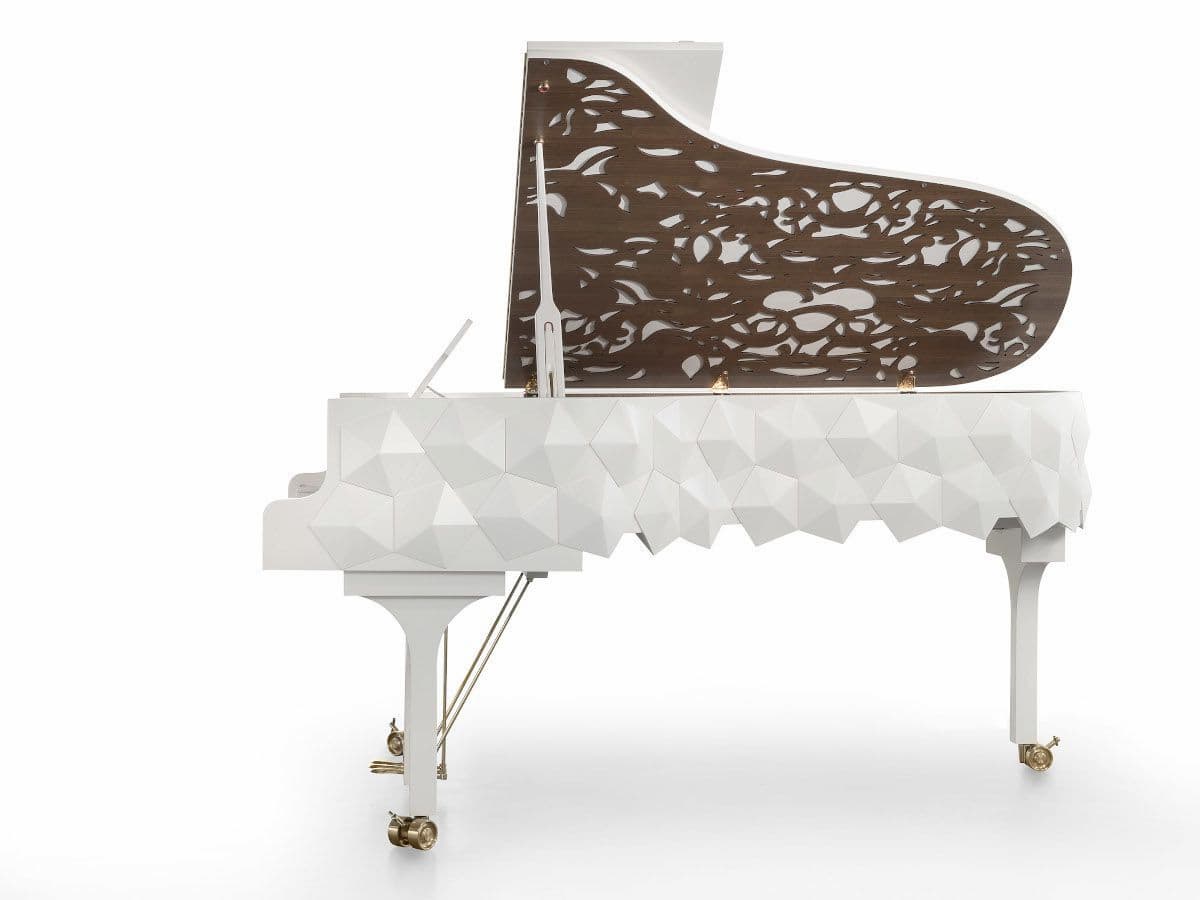
Origami Fairmont
Convinced that each piano has a unique sound that reveals the national character of its place of birth, Fazioli compares itself to Italian opera, “adding warmth and richness of its harmonics to produce a sunny, Mediterranean instrument.” It represents, in the eyes of the company, “not just technology, but a certain way of living.”
Fazioli: Debussy
With the “engine,” so to speak, left intact, custom modifications reshape the external part of the instruments, including the legs, pedals, and the music stand. Traditionally, the surface of a grand piano is covered in a black high-gloss or satin polyester finish. Fazioli now tells us that it is possible to request any other colour, and why not. The surfaces can also be veneered with different types of woods, including ancient and unusual timbers finished with high-gloss or satin polyester. One of the main features of the Fazioli Art Case project is represented by inlays in various types of wood, mother-of-pearl, semiprecious stones, metal or previously sculpted decorating elements. The company is also offering neutral surfaces that are ready to be decorated, hand-painted, or sprayed. Fazioli is quick to point out that “modifications of the casework do not compromise in any way the acoustic characteristics of the instruments.” Seeing is believing, so let’s have a look at some of the Fazioli Art Case products.
Fazioli: Liszt
Gold Leaf Piano

Gold Leaf Piano
If your kingdom, private residence, yacht, or luxury performance venue is in need of some golden bling, have a look at the “Gold Leaf Piano.” The interior engine is the F228, a semi-concert grand that is frequently used in chamber music performances. It is available in black, white, red, and blue surface colours, but in this special modification, it is covered head to toe, so to speak, in 24-karat gold leaf. High-gloss polyester finish seals the golden surface under a scratch resistant glassy surface. This particular design, valued at a quarter of a million US dollars, was apparently installed in a private home in Vancouver, in a space created by interior designer Thu Watson of Il Loft. Dipping bits in gold isn’t a particularly novel idea, and the Midas touch with respect to pianos is not unique either. The King of Rock, Elvis Presley, owned a nine-foot Kimball that was refinished in Gold Leaf, inside and out. If the Fazioli instrument reveals the national character of its place of birth, what does the “Gold Leaf Piano” reveal about the character of the owner? Your guess is as good as mine.
Fazioli: Rachmaninoff
Tamo Burl and Macassar Ebony
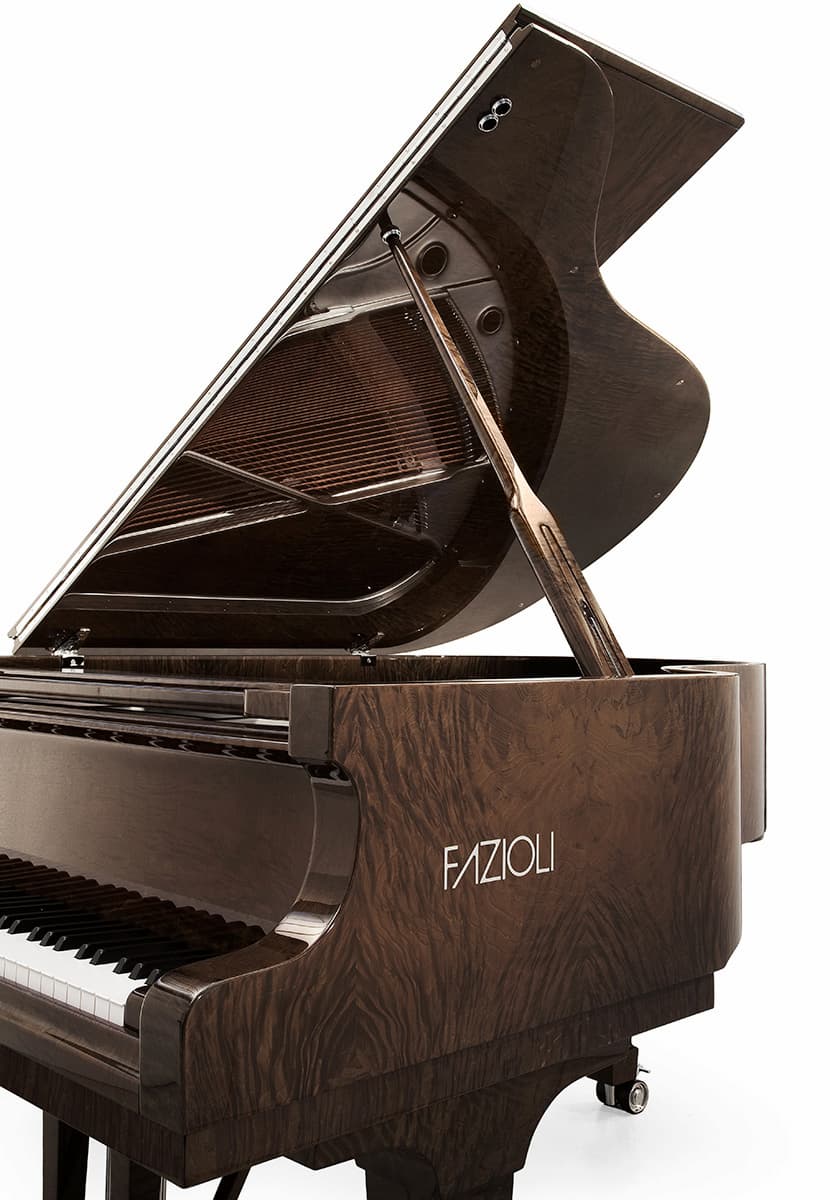
Tamo Burl
The F228 model has been clothed in a variety of art cases, including garbs of exotic timbers. Fazioli is already known for the resonant spruce used inside its instruments, which is harvested by special permit from the same forest where Stradivarius found the wood for his violins. For its Art Case exteriors, the company looks a bit further afield. One of the most exotic and rare woods, the Tamo Burl, is found in the mountainous regions of Japan. Native to Manchuria, that particular ash was transplanted to Japan centuries ago, and it features a uniquely figured grain resembling peanut shells laid side by side. That particular design is the result of strong vines encircling the trunk of the tree. This restricts the flow of nutrients, and the tree grows intermittently, as shown in the grain. Because it is so incredibly rare, this special timber was long in the exclusive preserve of Japanese royalty. It is now to be found in a piano near you.
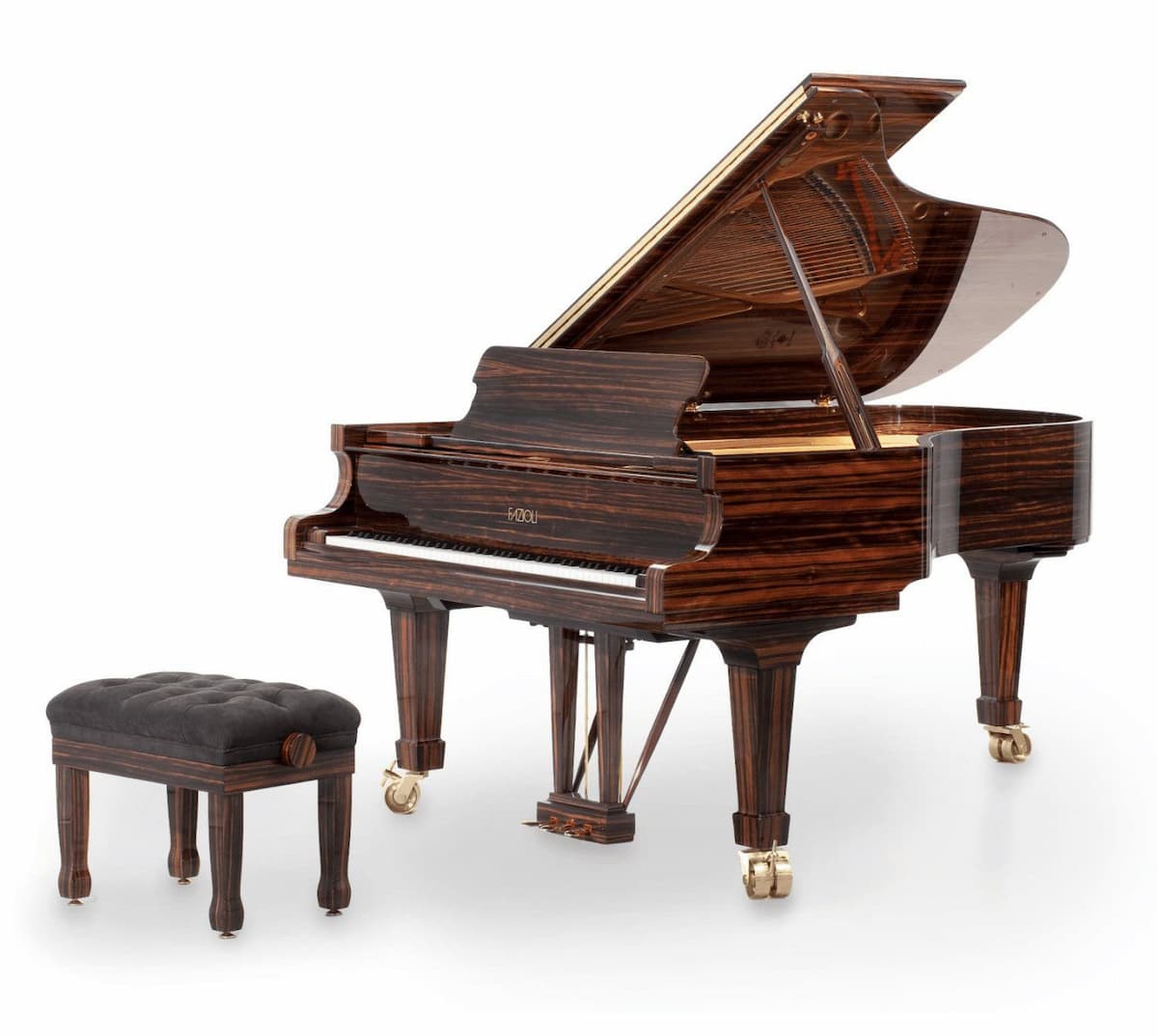
Macassar Ebony
The same holds true for the Macassar Ebony, a very rare and exotic wood from Asia. Its Latin name, “Diospyros celebica”, means “Fruit of the Gods,” and the tree grows to a height of fifty feet over the span of 100 years. The wood is also known as “Golden Ebony” for its patterns of black and dark chocolate browns overlaid with golden tones. It is an extremely dense and hard wood, and ancient Greeks drank from goblets shaped out of this wood. It was believed to possess magical powers to ward off evil intent. It remains to be seen and heard if these exotic piano cases made from rare and endangered woods are enough to ward off global deforestation or evil interpretations.
Fazioli: Mozart
Aria

Fazioli Aria
From the lush forests of Madagascar and the wind-blown highlands of the Japanese Alps, let us now float into interstellar space. Designed by French designer Philippe Gendre by NYT Line, the “Aria” took almost two years to build. The creators describe it as “shapes and colours blended into one another to form a single dynamic whole that recalls the design of a wave, the silhouette of a fish and the flight of a bird. This instrument lives in the air, together with the sound it produces.” Initially, the most striking feature appears to be the massive chrome pedestal with inlay triangles, producing an Art Deco effect. By concealing the pedal mechanism, the instrument makes a unified visual statement. However, that unity is completely asymmetrical, no matter the viewing angle. The lid is propped open by a chrome stick, and the tail and side create almost a triangle, “just like a sail of a boat outlined against the sun.” Supposedly, it creates an illusion of sailing over the air, “with the chrome details serving both as light reflectors and the texture counterpoint to the sleek ebony of the upper body of the piano.” This instrument—which does look like a concept car—will take you where no instrument has gone before, as in this case, the unusual design affects the sounding properties. Primarily, the sound is extended well beyond its traditional duration, and the bass notes reach “an unprecedented depth and fullness thanks to the confirmation of the basement.” To be sure, the instrument is visually stunning, but to my humble eye, the piano bench seems to have been a mere afterthought and not really part of the overall concept. Maybe in interstellar space, pianos drive themselves?
Fazioli: Bach
Brunei
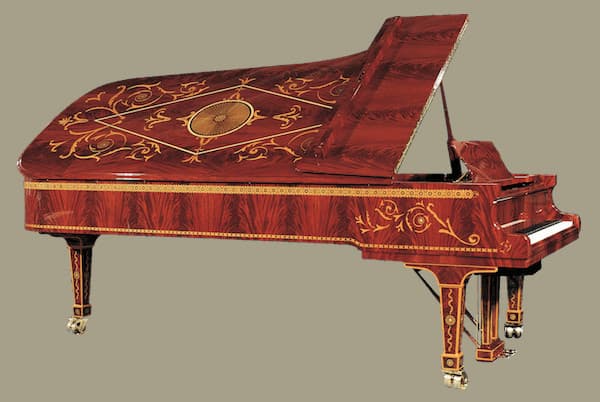
Brunei
The Sultan of Brunei, Hassanal Bolkiah, is one of the last absolute monarchs in the world. In addition, he is one of the wealthiest individuals currently roaming the globe. Being incredibly rich and enjoying sovereign immunity, the Sultan has stirred up a good bit of controversy. There have been allegations of sexual slavery, financial mismanagement, and more recently, he has outspokenly advocated introducing the death penalty for homosexuality and adultery; by stoning, no less. The Sultan also likes cars, owning the largest private car collection in the world. His humble vehicle collection of roughly 7,000 rare and rather expensive cars is estimated at a combined value of over 5 billion US dollars. It goes without saying that an individual of such versatility needs his own custom-made Art Case piano; enter the Fazioli Brunei. Underneath the lavish design, we find the flagship ten-foot grand F308. It is specifically designed for large-capacity concert halls, and it features a fourth pedal. Located to the left of the three traditional pedals, “it reduces the hammer-blow distance, thus reducing the volume without modifying the timbre, and at the same time facilitating the performance of glissandos, pianissimos, rapid passages and legatos.” The Art Case does have a special opulence that seemingly belongs in a fairy-tale palace. It uses sequoia burl inlaid with mother-of-pearl and semi-precious stones. The golden-brown of the sequoia wood serves as the backdrop to the classic infinity ribbons encircling the case. As expected, the wheels and hardware sparkle with gold, a filigree floral rosette is placed near the right-hand keyboard side, and the lid features a regal pattern of a large diamond with a crown jewel resting on a rosette of mother of pearl. Apparently, the Sultan was so happy with this initial instrument that he immediately ordered the Brunei II. Having two Art Case pianos at the Brunei Royal Palace should allow for expanding the musical repertoire. Of course, if the Sultan wants to see a performance of the Mozart “Lodron” concerto, he is still one instrument short.
Mozart: Piano Concerto for three pianos and orchestra in F major, K. 242
Marco Polo
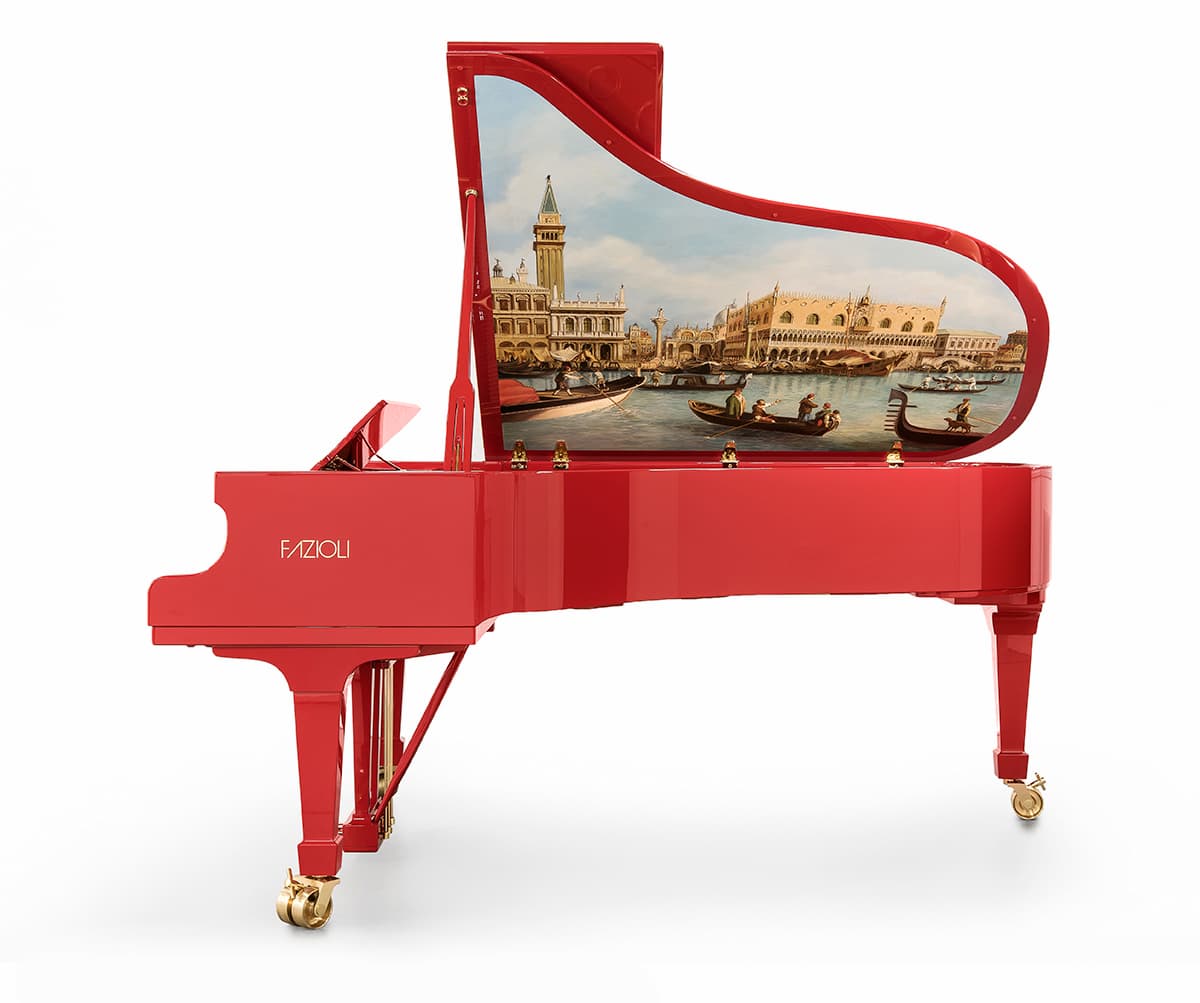
Marco Polo
The Venetian merchant Marco Polo is credited with revealing Chinese culture to the west through a series of stories of his travels. Traveling through Asia along the Silk Road, he described to Europeans the mysterious culture of the Eastern world, including the wealth and great size of the Mongol Empire and China during the Yuan Dynasty. Marco Polo wasn’t the first European to reach China, but he was the first to leave a detailed chronicle of his experience. As such, he was highly influential in cartography, literature, fellow explorers, and, more recently, piano Cases. A private Chinese client, wanting to celebrate the ancient connection between Venice and China, ordered a F308 in bright-red, high-gloss “Ferrari” colour. The inside lid features a hand-painted copy of the famed Canaletto painting of the Piazza San Marco, better known as St Mark’s Square. Fittingly, this specialty piano was given the name “Marco Polo.” As an optional attachment, the “Marco Polo” can be outfitted with a self-playing Player System, turning the instrument into a very expensive jukebox. A good many Art Case Pianos are unique and one-off creations. However, the “Marco Polo” proved highly popular, and Fazioli received several additional orders. As such, the company continues to offer this model in their Art Case portfolio. Recently, the first black “Marco Polo,” a F183 baby grand was ordered from China. Once again, the Canaletto painting graces the inside lid, but it is portrayed from a different angle. And in this case, the high-gloss black finish provides a rather impressive canvas.

The Butterfly
Imagination and your pocketbook are the only limiting factors in the world of the Art Case Piano. Many more are already on offer, including “The Butterfly” created by Bing Thom Architects for an architectural project in the heart of downtown Vancouver. Others are waiting to be created, and I wouldn’t be surprised to see a Bansky style project on the near horizon. Art Case Pianos can be ordered online, and all major credit cards are accepted. However, as the company sternly tells us, “all sales are final, and there can be no return or exchange.”
For more of the best in classical music, sign up for our E-Newsletter


